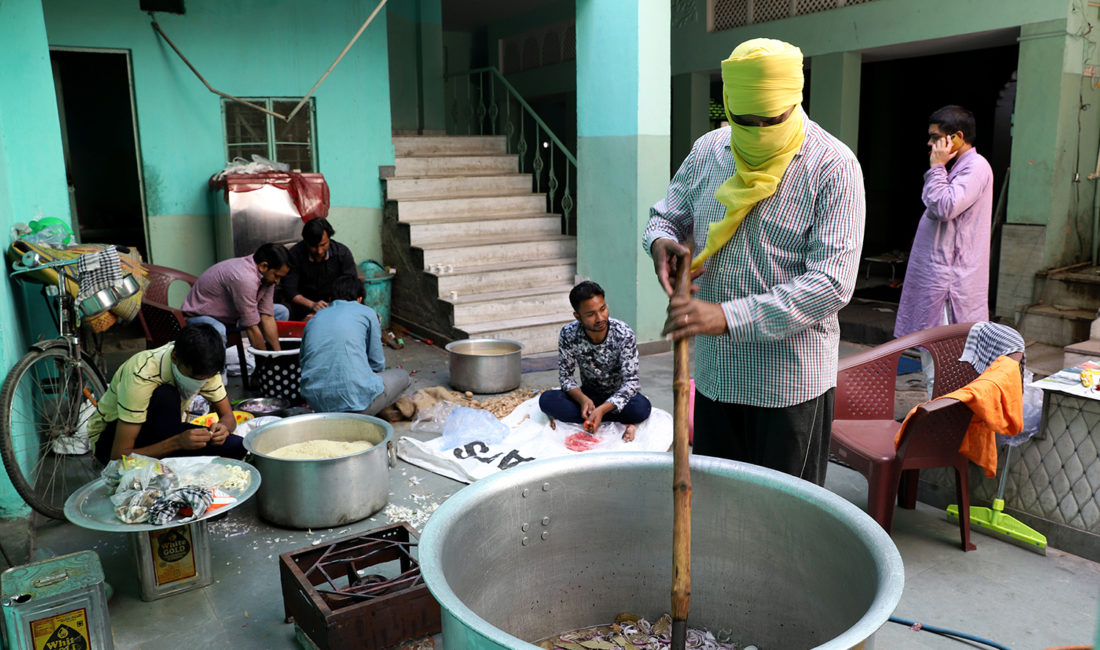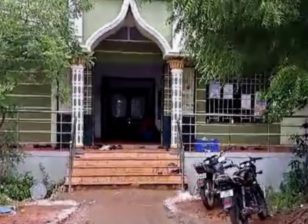In Delhi a Masjid and Gurudwara come together to feed workers starved by COVID-19 lockdownTUSHAR DHARA
A mosque and a gurudwara have come together in south Delhi’s Kalu Sarai neighbourhood to feed migrant workers driven to hunger by the COVID-19 lockdown. Every morning since 30 March, Harbans Singh and Surendar Singh, two volunteers from the Gurudwara Shri Singh Sabha in Kalu Sarai village, have been going to the nearby mosque, at 9 am. By that time, Aslam Chaudhury and a small group of people from the neighbourhood have already brought out a bag of rice from the storeroom, started cutting vegetables and sorting masalas. Onions, tomatoes, potatoes, beans, carrots and green peas have to be peeled and chopped, the ginger and garlic have to be ground in mixers into a fine paste and the oil needs to be readied. The menu remains broadly the same every day—mixed vegetable pulao, though on a day-to-day basis some of the vegetables may change. Soya bean chunks replace carrots and beans, or instead they prepare khichri with dal. “Rice is easy to cook and pack and the pulao is nutritious,” Chaudhury said. It needs to be so, he said, if the aim is to feed the hungry in slum clusters or labourers scattered in across Delhi who have will not have any other meal for the day.
On 24 March, Prime Minister Narendra Modi announced a 21-day nationwide lockdown to combat the spread of COVID-19. Reports started emerging the following day, of thousands of labourers beginning to walk hundreds of miles from urban centres such as Delhi and Mumbai, to their homes in neighbouring states. In such cities, people without fixed incomes—daily-wage labourers, residents of slums and blue-collar workers—saw their wages drying up as businesses, factories and small-scale manufacturing units closed down. News reports suggest a crisis of unemployment and hunger unfolding in these cities. The Delhi government has since announced some steps, such as setting up 500 hunger relief centres to feed 4 lakh people and starting hunger helplines. In several parts of the national capital, civil-society groups, individuals and religious institutions such as temples, mosques and gurudwaras are struggling to take up the responsibility of feeding thousands of workers. These are efforts that lack the scale and reach that the government can provide.
“The situation is very bad,” Chaudhury said when I met him on 31 March, at the mosque. “I have been getting desperate calls from Mehrauli, Hauz Khas village, Begumpur”—all localities of south Delhi—“for food.” Chaudhury’s kitchen started on 26 March, two days after Modi made the lockdown announcement. He runs a mess and a catering business and is familiar with the process of cooking in large quantities. He had initially hired some people to cook for the migrants but was disappointed with the food they made. Speaking of the langar at the gurudwara nearby, he said, “The langar is shut, so I asked them if I could borrow their vessels. They agreed.” Chaudhury said the gurudwara sent him two large vessels—a cauldron that can cook 25 kilograms of rice and a smaller one that can hold up to 10 kilograms. The gurudwara also sent two cooks, who could help Chaudhury prepare the food. “What we are doing here is not very different from what we do in the langar,” Harbans Singh, the langar supervisor who had come along with Surendar Singh, the cook, said. “It is god’s grace and we will do seva”—community service— “as long as the lockdown continues.”
Chaudhury was cooking in his basement mess on the first day that the gurudwara staff joined him. As the basement was dark and cramped, the next day, they shifted the kitchen to the now-vacant mosque. The day I visited, 10 kilograms of potatoes, 7 kilograms of tomatoes and onions and 2.5 kilograms each of carrots, beans and peas had been readied by the time I arrived, at 10 am. The rice had been soaked in water and the cauldrons were being prepared. Surendar Singh, known throughout Kalu Sarai as Billa, was cooking. Billa works in a school and spends the rest of his time in the gurudwara’s langar. Since both had shut down, he was devoting his energies to Chaudhury’s kitchen. He constantly instructed the younger men, telling them how to cut and clean the vegetables, as Harbans supervised the process while sitting on a chair. Every 15 minutes, one of the men would reach out for a blue bottle of hand sanitiser nearby and pass it around. Everyone in the room was either wearing a mask or had a handkerchief tied around their face.
“COVID-19 is a disease that was brought into India by the passport-holders and now the ration card holders are suffering,” Chaudhury said. “I got a call from Indirapuram in Ghaziabad yesterday and we crossed over to deliver some packets of food.” Chaudhury and his team have three government-issue lockdown passes which allows them to pass through police road blocks. They also use an expensive sports utility vehicle on their food runs. “Have you ever seen the police stopping expensive vehicles or harassing the drivers?” Chaudhury asked. “It’s the poor who bear the brunt.” The boot of the vehicle is large enough to hold bags filled with food packets and dry rations, he added.
On 29 March, Chaudhury and his team encountered a family of seven, including children, when they were going to the Sarai Kale Khan bus terminal to deliver food. They stopped and asked where they were going. “They were daily-wage labourers walking from Delhi to Kasganj in Uttar Pradesh, because their contractor had abandoned them without paying,” Chaudhury said. “They had no money to even buy milk for the children.” The team gave them some food.
It takes three hours to prepare the food, Billa said. By 1 pm, the food was ready to be packed. The team began ladling spoonfuls into plastic bags. “I instruct them to pack at least 400–500 grams so that it is filling,” Chaudhury said. Between 600 and 700 food packets are prepared and are ready for distribution by 2 pm, when the team sets out. They first go to Shahpur Jat, where a lot of Bengali and Bihari migrants work in the dyeing and tailoring industries. They distribute about 100 packets of food there. Their next stop is Hauz Khas village. Chaudhury said, “There is a Bihari basti”—slum—“away from the cafes and restaurants, we distribute another 100 packets there.” Around 150 packets are taken to Islam colony in Mehrauli and 150 each are given to hungry people in Begumpur and Kalu Sarai. Apart from food, the team also has “kits” of dry rations, consisting of wheat flour, rice, lentils, soap, hair oil, onions, tomatoes and potatoes.
It is usually 5 pm by the time they finish distributing the food and the team has to get back, wash the vessels and procure vegetables and rice for the next day. It is not possible to do dinner, so they try to ensure that each lunch packet they distribute has enough calories to sustain people till the next day. “We are doing everything in our capacity,” Chaudhury said. The vegetable supplier of his mess gives him good rates on materials, despite vegetable prices having spiked. “We have put our own money and people contribute what they can,” Chaudhury explains. “Of late, we have started receiving rice and cooking oil from people in Okhla and other places.” Chaudhary then added, “The lockdown has created so much panic. The government should have planned it a little better.”




